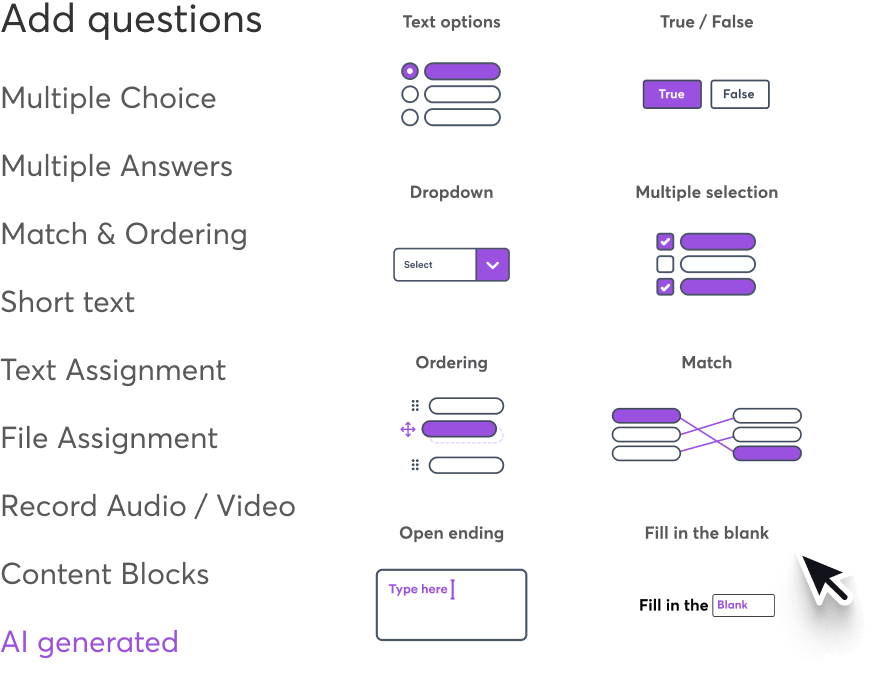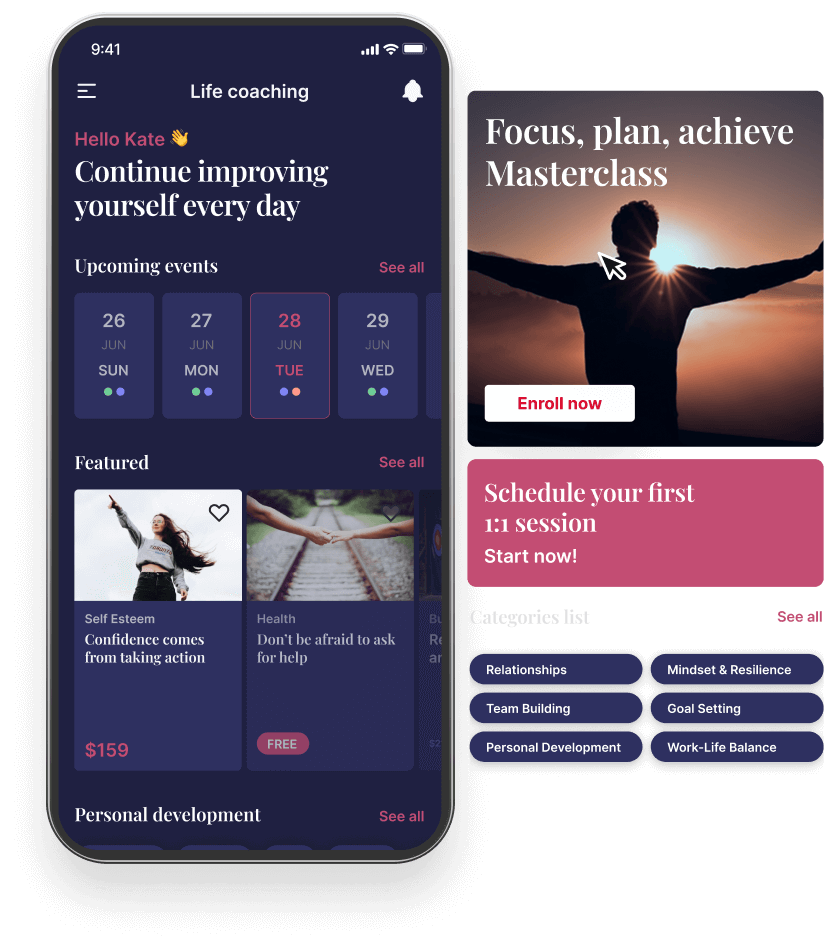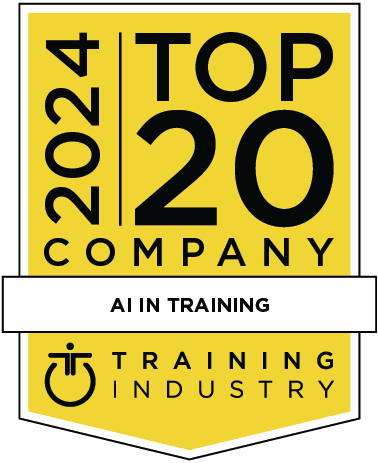The #1 AI-powered LMS built for course creators
What kind of academy would you like to create?
Loved by big brands and powerful platforms








Launch all kinds of powerful learning products
Courses
Training
Coaching
Certification
Webinars
Communities
Subscriptions
Create the ultimate elearning environment
Video
Personalization
SCORM
Communities
Assessments
Certifications

Interactive video
Bring learning to life. Use pop ups to provide further info, questions to strengthen understanding, and interaction to increase engagement.
Start a free trial

Personalized learning paths
Tailor lessons for every learner group with curated content, automated progress tracking and personalized navigation flows.
Start a free trial

SCORM
Import, launch, and track fully SCORM-compliant elearning content to create a smoother, more effective student experience.
Start a free trial

Community spaces and activites
Create unlimited social spaces and give your learners a place to discuss, dissect, and deepen their knowledge.
Start a free trial

Exams & assessments
Create flexible, learner-focused assessments with diverse question types, adaptive feedback, and robust grading tools—all supported by advanced AI.
Start a free trial
Certifications and badges
Reward achievements and boost credibility with customizable certificates and badges to recognize achievements, motivate learning and showcase skills.
Start a free trial
Build everything in your brand
From your domain name all the way down to your emails and notifications.
Templates
Website builder
Mobile App Builder
Multilingual
Custom Code
Your domain
50+ customizable site templates
Start a free trial

No-code website & page builder
Start a free trial

Drag-n-drop mobile app builder
Start a free trial

Multilingual & accessibility integrations
Start a free trial
Custom code
Start a free trial

Your domain on our hosting
Start a free trial
Your complete sales and marketing suite
Selling learning at scale has never been so simple.
1. Set up shop
Sell simple courses, create your own multi-category elearning store—and everything in between.
2. Promote your product
Connect your favorite marketing tools to centralize, monitor and optimize your campaigns.
3. Generate sales
Sell via subscription affiliate programs. Create sales funnels to increase conversions.
4. Get paid
Accept global payments and offer flexible options like installments and buy now, pay later.
A world of enterprise-ready features
Premium cloud servers
Multiple languages
40+ native integrations
Bulk user actions
Multiple SSO
Hubspot CRM
GDPR/ISO2700
Dedicated Account Manager
In-depth analytics
99.95% server uptime
User groups and tags
Powerful API / Webhooks
Custom user roles
User automations
Multiple schools
Seat management
Risk-free, affordable plans!
AI tools for your school available across all our plans.
Monthly
Yearly
Includes:
Create Courses
-
Unlimited Paid Courses
-
eBook Pages Builder
-
Exams & Quizzes
- 1:1 and Group Sessions
-
Drip-Feed Courses
Create your website
-
3-Page Website
- Site templates
- Connect with custom domain
- Multi-language site with Weglot
Get paid
-
3 Payment gateways
-
Flexible Checkout Options
- Coupons
Manage school
- 1 Admin
- Free SSL certificate
- Centralised tag manager
Connect your tools
-
Marketing tools integrations
- Accounting integrations
- Hubspot tracking code
Essential Help
- 24/5 e-mail support
- Help Center
Starter features
plus:
Increase engagement
-
Unlimited Free & Paid Courses
- Customizable Course Player
-
Assessments, Certificates & Digital Credentials
- Live Classes & Webinars
- 20 SCORMs / HTML5
Expand your school
-
Unlimited website pages
-
Mass emails
- Unlimited popups
-
Android & iOS Apps
-
Content Clone & Sync
Grow your revenue
- Subscriptions & Memberships
- Installments
- Funnels
Organize your team
- 5 Admins / Instructors
- Affiliate Marketing
- Users Import
Develop your ecosystem
- Advanced Zapier
Core Support
- 24/7 e-mail support
-
LearnWorlds Academy
Our Most Popular Plan
Starter & Pro features
plus:
Boost the learning experience
-
Interactive Videos
- Auto-Transcripts & Subtitles
- Advanced Assessments
- Multiple Accounts with Zoom, Webex, and Microsoft Teams
- Unlimited SCORMs / HTML5
Grow your Academy
- Remove LearnWorlds Brand
- School cloning
- In-School Clone & Sync
-
Cross-schools Clone & Sync
Access insightful reporting
- Progress Reports / User Segments
-
Course Insights
- Scheduled Reports
-
Report templates
Boost efficiency
- Automations
- Bulk User Actions
- 25 Admins / Collaborators
- Custom User Roles
- 10 Seat & User Group Managers
Extend your capabilities
- API & Webhooks
- 3 SSO
- Hubspot (advanced)
Premium Assistance
- 24/7 priority email support
- Personalized onboarding
No transaction fees
All features
plus:
Extra data safety
- 99.95% Server Uptime
- Premium Cloud Servers
- Multiple Daily Backups
- Optional custom SLA
- Optional contract and DPA
- 8 SSO
Flexible management options
- Custom no. of Admins / Collaborators
- Custom no. of Seat & User Group Managers
- Tailored Pricing Options
- Flexible Invoicing
Dedicated Guidance
- Dedicated Success Manager
- 24/7 priority email & phone support

By signing up, you agree to the Terms & Conditions and the Privacy Policy.
Already have a LearnWorlds account? Log in



































